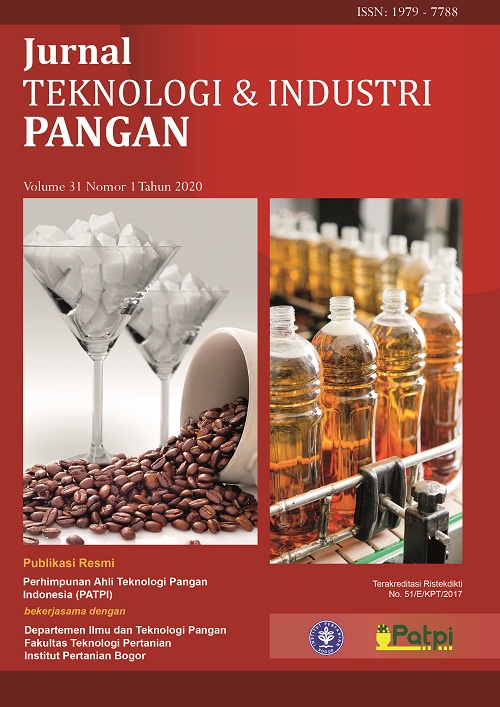Abstract
The objective of this study was to analyze the nutrition content, antioxidant activity, mineral bio-availability and amino acid composition of a bee pollen snack bar. This study was a pure experimental study along with complete randomized design. The treatment factor was the addition of bee pollen which resulted in five formulas. The product was made from Sormeal, rice crispy, chocolates, dates, cashews and bee pollen. Formula F3 with the addition of bee pollen of 10% was analyzed for its nutrient content, antioxidant activity and availability of Fe and Zn. The F3 formula contained 5.91% water, 1.72% ash, 11.30% protein, 16.52% fat and 64.52 carbohydrate. The antioxidant activity test of the product was 10.77 mg ascorbic acid/g sample. Meanwhile, the bioavalaibility of Fe and Zn of the product were 17.02 and 6.84 mg/kg, respectively. This product can be considered as a nutritious snack that could improve imunity and potentially improve school-aged children learning performance.
References
[AOAC] Association of Official Analytical Chemist. 2006. Official Method of Analysis of Association of Official Analytical Chemist. Ed ke-16. AOAC Inc, Airlangton.
Aaron GJ, Lo NB, Hess SY, Guiro AT, Wade S, Ndiaye NF, Guinard JX, Brown KH. 2011. Acceptability of complementary foods and breads prepared from zinc-fortified cereal flours among young children and adults in Senegal. J Food Sci 76: 56-62. DOI: 10.1111/j.1750-3841. 2010.01909.x.
Attia YA, Abd Al-hamid AE, Ibrahim MS, Al-Harthi MA, Bovera F, Elnaggar AS. 2014. Productive performance, biochemical and hematological traits of broiler chickens supplemented with propolis, bee pollen, and mannan oligosaccha-rides continuously or intermittently. Livest Sci 164: 87-95. DOI: 10.1016/j.livsci.2014.03.005.
Basista K, Filipek B, Sodzawiczny K. 2012. Bee pollen allergy in polish beekeepers and their fa-mily. Dermatologi Alergologi 29: 343-347. DOI: 10.5114/pdia.2012.31486.
Beltrán-Navarro B, Matute E, Vasques-Garibay E, Zarabozo D. 2012. Effect of chronic iron defi-ciency on neuropsychological domains in in-fants. J Child Neurol 27: 297-303. DOI: 10.117 7/0883073811416867.
[BSN] Badan Standardisasi Nasional. 2011. SNI standar mutu cookies (SNI: No 01-2973-1992). http:/www.sisni.bsn.go.id [3 April 2018].
Campos MGR, Frigerio C, Lopes J, Bogdanov S. 2010. Review article: What is the future of bee-pollen?. J ApiProduct ApiMedical Sci 2: 131-144. DOI: 10.3896/IBRA.4.02.4.01.
Candra AA, Setiawan B, Damanik R. 2013. Pe-ngaruh pemberian makanan jajanan, pendidik-an gizi, dan suplementasi terhadap status gizi, pengetahuan gizi, dan status anemia pada anak usia sekolah dasar. J Gizi Pangan 8: 103-108. DOI: 10.25182/jgp.2013.8.2.103-108.
de Arruda VAS, Pereira AAS, Freitas AS, Barth OM, Almeida-Muradian LB. 2013. Dried bee pollen: B complex vitamin, physicochemical and bo-tanical composition. J Food Comp Anal 29: 100-105. DOI: 10.1016/j.jfca.2012.11.004.
Estevinho LM, Rodrigues S, Pereira AP, Feás X. 2012. Portugese bee pollen: Palynologycal stu-dy, nutritional and microbiological evaluation. Int J Food Sci Tech 47: 429-435. DOI: 10.1111/ j.1365-2621.2011.02859.x.
Fatrcová-Šramková, Nôžková J, Máriássyová M, Kačániová M. 2016. Biologically active anti-microbial and antioxidant substances in the Helianthus annuus L. bee pollen. J
Environ Sci Health B51: 176-181. DOI: 10.1080/03601234.2 015.1108811.
Fu M, Cheng L, Tu S, Pan W. 2007. Association bet-ween unhealthful eating patterns and unfavo-rable overall school performance in children.J Am Diet Assoc 107: 1935-1943. DOI: 10.1016/j. jada.2007.08.010.
Grosso G, Estruch R. 2015. Nut consumption and age-related disease. J maturitas 84: 11-16. DOI: 10.1016/j.maturitas.2015.10.014.
Husby I, Heitmann BI, Jensen KO. 2009. Meals and snack from child’s perspective: The contribution of qualitative method to development of dietary intervention. Public Health Nutr 12: 739-747. DOI: 10.1017/S1368980008003248.
Kustyawati ME, Susilawati, Tobing D, Trimaryanto. 2012. Profil asam lemak dan asam amino susu kambing segar dan terfermentasi. J Teknol Industri Pangan 23: 47-52.
Lachman J, Orsák M, Hejtmánková A, Kovářová E. 2010. Evaluation of antioxidant and total phe-nolic of selected Czech honey. LWT-Food Sci Technol 43: 52-58. DOI: 10.1016/j.lwt.2009.06. 008.
Mah E, Schulz JA, Kaden VN, Lawless SL, Rotor J, Mantila LB, Liska DJ. 2017. Cashew consum-ption reduces total and LDL cholesterol: a ran-domized, crossover, controlled-feeding trial. Am J Clin Nutr 101: 1070-1078. DOI: 10.3945/ ajcn.116.150037.
Marjan AQ, Marliyati A, Ekayanti I. 2016. Pengem-bangan produk pangan dengan substitusi red palm oil sebagai alternatif pangan fungsional tinggi beta karoten. J Gizi Pangan 11: 91-98.
Nagai T, Inoue R, Suzuki N, Tanoue Y, Kai N, Naga-shima T. 2007. Antihypertensive activities of en-zymatic hydrolysates from honeybee-collected pollen of Cistus ladaniferus. J Food Agric Environ 5: 86-89.
Pasricha SS, Flecknoe-Brown CS, Allen JK, Gibson RP, McMahon PL, Olynyk KJ. 2010a. Diagnosis and management of iron deficiency anaemia: A clinical update. Med J Australia 193: 525-532. DOI: 10.5694/j.1326-5377.2010.tb04038.x.
Pasricha SR, Black J, Muthayya S, Shet A, Bhat V, Nagaraj S, Prashanth NS, Sudarshan H, Biggs BA, Shet AS. 2010b. Determinants of anemia among young children in Rural India. Pediatrics 126: 140-149. DOI: 10.1542/peds.2009-3108.
Prado EL, Dewey KG. 2014. Nutrition and brain de-velopment in early life. Nutr Rev 72: 267-284. DOI: 10.1111/nure.12102.
Rachmayani N, Rahayu WP, Faridah DN, Syamsir E. 2017. Snack bar tinggi serat berbasi tepung ampas tahu (okara) dan tepung ubi ungu. J Teknol Industri Pangan 28: 139-149. DOI: 10. 6066/jtip.2017.28.2.139.
Rzepecka-Stojko A, Stojko J, Kurek-Górecka A, Górecki M, Kabała-Dzik A, Kubina R, Moździerz A, Buszman E. 2015. Polyphenols from bee pollen: structure, absoption, metabolism and biological activity. Molecules 20: 21732-21749. DOI: 10.3390/molecules201219800.
Sakti B. 2015. Pengembangan Pasar Produk Sor-meal Sebagai Pangan Fungsional Dan Komo-diti Diversifikasi Karbohidrat [Skripsi]. Bogor: Fakultas Teknologi Pertanian, Institut Pertanian Bogor.
Sandjaja S, Budiman B, Harahap H, Ernawati F, Soekatri M, Widodo Y, Sumedi E, Rustan F, Sofia G, Syarief SN, Khouw I. 2013. Food con-sumption and nutritional and biochemical status of 0.5-12-year-old Indonesian children: the SEANUTS study. British J
Nutr 110: 11-20 DOI: 10.1017/S0007114513002109.
Suani. 2012. Potensi sorgum sebagai bahan pangan fungsional. J IPTEK Tanaman Pangan 7: 58-66.
Winarno FG. 2008. Kimia Pangan dan Gizi. 28-31. PT Gramedia Pustaka Utama, Jakarta.
Yang K, Wu D, Ye X, Liu D, Chen J, Sun P. 2013. Characterization of chemical composition of bee pollen in China. J Agric Food Chem 61: 708-718. DOI: 10.1021/jf304056b.
Yasmin G, Madanijah S. 2010. Perilaku penjaja pa-ngan jajanan anak sekolah terkait gizi dan ke-amanan pangan di Jakarta dan Sukabumi. J Gizi Pangan 5: 148-157. DOI: 10.25182/jgp. 2010.5.3.148-157.

